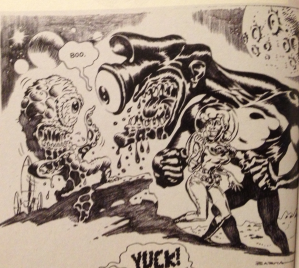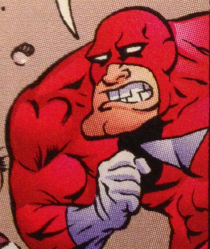Splash Brannigan General Background

Panel showing the entire cast of recurring Splash Brannigan characters: L to R, Splash Brannigan, Miss Daisy Screensaver, and Sidney J. Kaput. Tomorrow Stories Special, No.1, Page 2, panel 1. Art by Hilary Barta
This page is my attempt to familiarize readers with some overarching themes in Splash Brannigan stories. Splash was created by Alan Moore and Hilary Barta, who collaborate on nearly all the stories where he appears. Below are some recurring themes, then inspirations, then recurring characters. If I missed stuff, lemme know in the comments!
>Return to Splash Brannigan Annotations Index
THEMES
- Humor/Satire – Splash is not a serious super-hero. There’s no real attempt at continuity, nor dare-I-say plausibility (even in the limited sense that a superhero comic might be internally marginally plausible.) Splash is a satirical super-hero vehicle for taking on various satirical themes, including the art world, comics fandom, noir mystery, etc.
I think Moore is a great humorist; he makes me laugh at least now and then. Other primarily humorous comics series of his include the First American, the Bojeffries Saga, and D.R. & Quinch. A lot of Moore’s work includes homage, including plenty of satiric elements; there’s a lot of this throughout Tomorrow Stories (where Splash appears) but it’s all over his oeuvre – from Supreme to 1963.
Splash stories are full of running gags, especially including ones about how his ink stains things, including: narration “Splash Brannigan: who he is and how to get him out of your tablecloth (hint: scissors)” (TS6, P4, p3), Splash dialogue: “I’ll pick up the bill at the dry cleaners! I have an account there” (TS7, P5, p1), and Miss Screensaver dialogue: “This outfit was just cleaned!” (TS9, P1, p1) - Comics – Splash is the creation of comic artist. Miss Screensaver works as an artist for Kaput Comics. This gives Moore a humorous vehicle to take critical jabs at the comics industry, comic conventions, the banality of superheroes, etc.
- Rhyme – Splash is full of rhymes – almost to the point of irritation sometimes. My favorite (from TS7, P2, p1-2) is “the Valerie Calorie Gallery Salary.”
- Sexism – Sometimes Splash stories tread a fine line between being sexist and humorously poking fun at sexist attitudes. Mostly, though I think Moore self-consciously cleverly parodies sexism, especially in the dialog he writes for and about Miss Screensaver. Examples include Screensaver’s deprecating statement “…but then I’m a girl!” (TS 7, P2, p1) and Splash’s statement “maybe Daisy was right even though she’s a woman” (ABC 64PG, P2, p3.) Splash displays a lot of sexist behavior, including grabbing Miss Screensaver’s breast when she falls asleep (evidenced by the ink handprint in TS6, P6, p1) and singing misogynist lyrics (“Daisy’s my bitch” in TS11.)
I think it’s funny and clear that it’s drawing attention to the prevalence of sexism in the popular culture that Moore is parodying… but if other readers out there, especially women, see it differently, please comment. (See also Wally Wood under influences below.)
INSPIRATIONS/INFLUENCES
- Early Animation – There are ongoing references to 1920s-1930s animation, including Koko the clown, Bimbo the dog, and Betty Boop (all three appear in the wonderful 1933 Saint James Infirmary Blues video animation excerpt above.) Splash’s zany goes-anywhere “quirky visual novelty” (ABC 64PG, P4, p2) has some of the great energy of these very innovative, very clever, very smart cartoons. The animation homage is referenced throughout ABC 64PG, also briefly in TS6, TS7, and ABC A-Z.
- Mad – The manic multiple-gags-per-panel energy of Splash Brannigan resembles early Mad. There are plenty of references to very specific Mad gage, including a few ongoing cameos by minor characters, Mrs. Gowanus and Bumble, both from early Mad comics stories, by Bill Elder and Harvey Kurtzman. Some Splash stories echo early Mad stories, for example, TS Special No. 1 film noir detective adventure kinda resembles Mad No.7’s Shermlock Shomes.
- Plastic Man – Referenced specifically in the final panel of ABC 64PG, Jack Cole’s Plastic Man was a visually-inventive early comic, with very little regard for continuity. Art Spiegelman and Chip Kidd’s excellent book Jack Cole and Plastic Man: Forms Stretched to their Limits describes Plastic Man as manic, surreal, and exuberant, which describes Splash pretty well, too. “Plas” was the original stretch-o superhero, often imitated. Splash stretches/contorts/shapes somewhat similarly to Plastic Man.
-
Wally Wood – Visually, I think Hilary Barta’s style draws a lot from the work of comic book artist Wally Wood, who was one of the early Mad artists. There’s only one fairly explicit Wood image reference in an actual story (ABC A-Z, P1, p2) but Barta does a couple Wood-homage sketches in ABC Sketchbook (and, with Moore, a clear Wally Wood homage parody story Space Family Strong in Tom Strong No.14.) Barta’s shading is Wood-like, especially in machinery (example TS9, P1, p2.) I think that Miss Screensaver resembles the idealized male-fantasy women Wood drew (example), which perhaps somewhat undermines (or perhaps underlines?) the running commentary on sexism.
RECURRING CHARACTERS
- Splash Brannigan – Splash Brannigan, Indelible Avenger is made of 4-dimensional ink, which allows him to do pretty much anything that story purposes require – stretch, pour, stain, swirl, turn-into-giant-scissors, etc. etc. He goes by lots of clever nicknames: our pourable paragon, the stream supreme, the dribbling dynamo, etc.
-
Miss (Daisy) Screensaver – Arguably Splash’s love interest, or at least the woman he kinda likes, you know, in small doses. She works as an artist at Kaput Comics. She’s smarter and more capable than the men around her give her credit for. Moore’s meaningful meaty moral messages are often put into Daisy’s dramatic dialogue, for example “Comics should be about ideas, aesthetics, fun and ingenuity!” in TS8, P6, p2. Mercifully she only gets taken hostage once, by a giant on-screen animated dog.
-
Sydney J. Kaput – Kaput is the big-nosed slave-driver editor of Kaput Comics. He’s sometimes a kind of Stan Lee stand-in… though less savvy, more pathetic. A running gag is that Kaput is continually trying to commit suicide, due to the poor economic state of the comics industry, which he gives 6 months. TS11 features Kaput’s convenient look-alike cousins in music and film: Tony Finito and Armand Dedin-de-Wateur; all their last names are slang for over, finished, dead.
-
Kaput Comics characters – Sarcastic Thug (costumed superhero kind of like Superman and the Hulk) and Ferdy the Fantom Fetus (cartoony thing kinda resembling Casper the Ghost) appear occasionally.
>Return to Splash Brannigan Annotations Index




Leave a comment